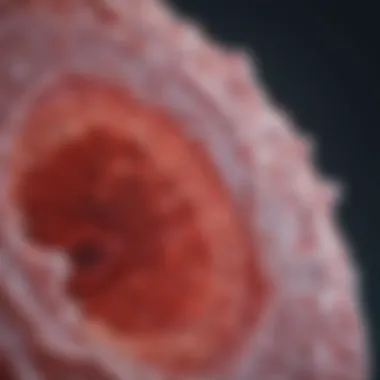Lung Cancer Laboratory Tests: A Comprehensive Overview


Intro
Lung cancer remains a pressing health challenge across the globe. The complexity of diagnosing and managing this disease highlights the necessity for precise laboratory tests. Effective management hinges not only on early detection but also on the ability to tailor treatments to individual patients. In this context, laboratory tests play an instrumental role. This section serves as a foundation for understanding each type of test utilized in the diagnosis and evaluation of lung cancer, ensuring that readers grasp their significance in the broader landscape of personalized medicine.
Research Context
Background and Rationale
Lung cancer accounts for a considerable percentage of cancer-related deaths worldwide. Factors such as smoking, environmental pollutants, and genetic predispositions contribute to its prevalence. Accurate diagnosis is critical, as it dictates treatment options and ultimately impacts patient outcomes. Laboratory tests are essential tools in this process, providing vital insight into the characteristics of tumors and informing clinical decisions.
Literature Review
Numerous studies have explored the utility of various laboratory tests in the management of lung cancer. Research indicates that advancements in imaging techniques, histopathology, and molecular diagnostics have improved diagnostic precision. A deeper examination of these studies reveals a consensus on the importance of an integrated diagnostic approach.
"The integration of multiple testing modalities is crucial for enhancing the accuracy of lung cancer diagnosis and optimizing treatment pathways."
To further comprehend the role of laboratory tests, it is important to explore the methodologies used to gather and analyze the relevant data. This understanding will pave the way for appreciating the implications of these tests in lung cancer management.
Methodology
Research Design
A descriptive research design is employed to examine laboratory tests in lung cancer diagnosis and evaluation. This design allows for systematic analysis of the various laboratory methods, their developments, and applications in practice. By categorizing the tests, researchers can delineate their specific contributions to the diagnosis and treatment process.
Data Collection Methods
Data collection involves a comprehensive review of existing literature, clinical guidelines, and recent advancements in laboratory methodologies. Sources include peer-reviewed journals, medical databases, and authoritative health organization publications.
Key laboratory tests, including imaging techniques like CT scans, histopathological examinations, and molecular diagnostic assessments, will be discussed in later sections. The insights gained from these methodologies highlight their critical role in enhancing diagnostic pathways, consequently informing treatment strategies.
Prologue to Lung Cancer
Lung cancer remains one of the most pressing health issues worldwide, affecting millions and carrying a high mortality rate. In this article, we aim to provide an in-depth examination of lung cancer laboratory tests, understanding their critical role in diagnosis, monitoring, and treatment. Accurate identification of the disease is essential, as lung cancer can often present with non-specific symptoms, leading to late-stage detection.
Laboratory tests serve as a foundational element in the lung cancer diagnostic process. They not only aid in confirming the presence of cancer but also help in determining the specific type of lung cancer and its characteristics. This knowledge allows healthcare providers to develop tailored treatment strategies, thus increasing the chances of improving patient outcomes.
Understanding lung cancer involves various aspects, including its biological behavior, the stages of the disease, and the response to treatment modalities. Consequently, laboratory tests play a crucial role in this multifaceted approach.
Overview of Lung Cancer
Lung cancer primarily manifests in two major forms: non-small cell lung cancer (NSCLC) and small cell lung cancer (SCLC). NSCLC is the most prevalent type, accounting for approximately 85% of all lung cancer cases. It is a heterogeneous group of cancers, including adenocarcinoma, squamous cell carcinoma, and large cell carcinoma. SCLC, although less common, is known for its aggressive nature and rapid growth rate.
Key Points about Lung Cancer:
- Etiology: Smoking remains the leading cause of lung cancer, although non-smokers can also develop the disease due to environmental exposure to carcinogens, genetic predispositions, and other health conditions.
- Symptoms: Common symptoms include persistent cough, chest pain, weight loss, and shortness of breath. These symptoms may vary depending on the cancer's type and stage.
- Stages: Lung cancer is staged from I to IV, with Stage I being localized and Stage IV indicating advanced disease with metastasis.
Global Statistics and Impact
The prevalence and impact of lung cancer are significant on a global scale. According to the World Health Organization, lung cancer is the leading cause of cancer mortality. In 2020, an estimated 1.8 million deaths were recorded due to lung cancer, demonstrating the urgent necessity for effective diagnostic and treatment methods.
"Lung cancer accounts for nearly one in five cancer deaths globally."
Several factors contribute to lung cancer rates, including:
- Geographical Variation: Incidence rates vary widely, with higher rates often found in countries with high smoking prevalence.
- Age Factors: The risk of lung cancer increases with age, especially in individuals over 65.
- Gender Differences: Historically, lung cancer has been more common in men, but the rates among women have been rising due to increased smoking rates among females.
Efforts to improve awareness, enhance screening programs, and expand access to innovative treatments may help reduce the burden of this disease in the future. Understanding the critical role of laboratory tests in lung cancer diagnosis is pivotal for improving patient outcomes and advancing research.
Importance of Laboratory Tests
Laboratory tests are central to lung cancer management and play a crucial role in shaping patient outcomes. Accurate diagnostics underpin effective treatment pathways. They provide vital information about the disease's stage, type, and potential response to therapy. In this sense, laboratory tests are not just supplementary; they are integral to understanding lung cancer comprehensively.
Role in Diagnosis
Laboratory tests facilitate the accurate diagnosis of lung cancer. They allow clinicians to confirm the presence of cancer cells and distinguish between different types of lung cancer. For instance, tissue biopsies provide cellular information on the tumor, revealing critical details about its nature. Cytological analysis examines samples from pleural fluid or sputum, offering insights into the cancer’s characteristics.
Additionally, molecular diagnostics, particularly genetic testing, offer more than just confirmation of lung cancer. They reveal specific mutations or markers that can indicate which treatments are likely to be most effective. Physicians can determine targeted therapies aligned with a patient’s unique cancer profile, which is essential for personalized medicine.
"Laboratory tests serve as the cornerstone of lung cancer diagnostics, forming the bridge between clinical suspicion and definitive disease identification."
Role in Monitoring
Monitoring lung cancer after diagnosis is equally critical. Laboratory tests help track disease progression and treatment effects. For example, regular imaging studies can reveal changes in tumor size or metastasis, informing treatment adjustments. In addition, blood tests for circulating tumor markers provide non-invasive methods to gauge the cancer's response to therapy.


Such tests can indicate rising levels of tumor markers, suggesting disease advancement or recurrence. Consequently, this capacity to monitor allows healthcare providers to make timely decisions about patient care. This dynamic approach not only improves individual patient outcomes but also helps in understanding overall trends within lung cancer management.
In summary, the role of laboratory tests extends beyond initial diagnosis. They are essential for ongoing assessment and tailored therapies, fostering a better prognosis for patients with lung cancer.
Imaging Techniques
Imaging techniques play a crucial role in the diagnosis and management of lung cancer. These methods allow for visualization of the lungs, aiding in the detection of tumors, assessment of their size, and monitoring of disease progression. Each imaging modality has unique benefits and considerations that contribute to a comprehensive evaluation of lung health. It is essential to understand the specific applications of these techniques to improve diagnostic accuracy and treatment outcomes.
Chest X-Ray
Chest X-ray is often the first step in lung cancer evaluation. This quick and accessible technique can help identify abnormal growths or nodules in the lungs. While it is not always definitive, a chest X-ray can indicate the presence of cancerous masses or pulmonary complications.
The primary advantages of a chest X-ray include:
- Accessibility: Chest X-rays are widely available in healthcare facilities.
- Speed: Results are typically immediate, allowing for prompt decision-making.
- Cost-Effective: This method is less expensive compared to other imaging modalities.
However, there are limitations. A chest X-ray may miss smaller lesions, and further testing is often needed for confirmation.
Computed Tomography (CT) Scan
Computed Tomography (CT) scans provide more detailed images than chest X-rays. They offer cross-sectional views of the lungs, which can help in identifying the exact size and shape of tumors. CT scans allow for better visualization of surrounding structures, such as lymph nodes and blood vessels.
The CT scan is particularly useful for:
- Staging Cancer: It helps classify the extent of disease spread.
- Guiding Biopsies: Providing precise locations for tissue extraction.
- Monitoring Treatments: Assessing response to therapies over time.
Despite its advantages, CT scans expose patients to higher levels of radiation than standard X-rays, which raises concerns for repeated use.
Magnetic Resonance Imaging (MRI)
Magnetic Resonance Imaging (MRI) is less commonly used than CT scans in lung cancer evaluation, primarily due to the challenges in imaging lung tissue effectively. However, MRIs can be beneficial in specific scenarios, such as assessing tumors near the chest wall or evaluating metastasis in the brain or spinal cord.
Key points about MRI in lung cancer include:
- No Ionizing Radiation: MRI uses magnetic fields, making it safer for repeated use.
- Soft Tissue Contrast: It excels at distinguishing between various soft tissue types.
The limitations also exist. MRIs are time-consuming and less effective in detecting small lesions within the lungs compared to CT.
Positron Emission Tomography (PET)
Positron Emission Tomography (PET) scans offer unique insights by detecting metabolic activity of cells. In lung cancer, PET scans are often combined with CT (PET/CT) to enhance diagnostic capabilities. This hybrid approach allows for the simultaneous assessment of both structural and functional characteristics of tumors.
The benefits of PET scans include:
- Metabolic Information: It indicates tumor activity, which aids in grading.
- Whole-Body Imaging: PET scans can help identify metastases early.
However, the limitations include:
- Cost: PET scans are more expensive than conventional imaging.
- False Positives: Non-cancerous conditions may also show increased metabolic activity.
In summary, imaging techniques are fundamental in the comprehensive evaluation of lung cancer. Each modality, from chest X-rays to PET scans, has its strengths and limitations, contributing to a better understanding of the disease and facilitating appropriate management.
Accurate imaging is essential for effective lung cancer diagnosis and treatment.
Histopathological Examination
Histopathological examination plays a crucial role in the diagnosis and management of lung cancer. This process involves studying tissue samples under a microscope to examine the presence and characteristics of cancer cells. Accurate assessment of tumor cells provides invaluable information about the type of lung cancer, its aggressiveness, and the appropriate treatment options available.
Histopathological examination is particularly significant as it allows for the classification of lung tumors into subtypes. These subtypes often have distinct biological behaviors and responses to treatment. For instance, non-small cell lung cancer (NSCLC) can be further categorized into adenocarcinoma, squamous cell carcinoma, and large cell carcinoma. Identifying the exact subtype may significantly affect treatment decisions, such as the use of targeted therapies intended for specific mutations.
The benefits of histopathological examination also extend beyond mere classification. The presence of specific cellular features can indicate the cancer's stage, guiding clinicians in determining the most effective management strategies. Furthermore, detailed analysis can reveal other critical factors, such as tumor grade and histological features, which contribute to prognostic evaluations.
Key considerations during the histopathological examination include the method of tissue collection and preparation. Different techniques, such as needle biopsies or resection samples, may yield varying amounts of tissue and quality of samples, affecting the overall accuracy and reliability of results. Hence, the selection of the biopsy technique should be tailored to the patient’s condition and the tumor's location.
"Histopathological examination is a foundational element in the management of lung cancer, influencing both diagnostic accuracy and therapeutic approaches."
In summary, the histopathological examination is an essential tool in the arsenal against lung cancer. It not only assists in establishing a definitive diagnosis but also enhances the understanding of the disease's nuances, thereby informing personalized treatment plans.
Tissue Biopsy
Tissue biopsy is a key component of histopathological examination for diagnosing lung cancer. It involves the removal of a small section of lung tissue for analysis. Different techniques can be used to obtain tissues, including fine needle aspiration, core needle biopsy, and excisional biopsy. The choice of method often depends on the size and location of the tumor, along with the overall health of the patient.
The results from a biopsy offer direct evidence of malignancy by allowing pathologists to observe the architecture and cellular characteristics of the tissue. Accurate interpretation of biopsy results can lead to early diagnosis, significantly impacting patient outcomes. The ability to detect specific mutations in the biopsy sample can also guide targeted therapy decisions, enhancing personalized treatment strategies.


Cytological Analysis
Cytological analysis involves the examination of individual cells obtained from body fluids or smears. In lung cancer, this is often performed using samples obtained from bronchoscopy, pleural effusion, or sputum analysis. Though less invasive than a tissue biopsy, cytological analysis can provide crucial insights into the presence of malignant cells.
While cytology is an effective means of detecting lung cancer, its diagnostic sensitivity may vary compared to histopathological examination. It is commonly used as a complement to other diagnostic methods, especially when patients are not suitable candidates for invasive biopsy procedures. Accuracy in cytological diagnosis is vital, as it directly influences clinical decisions and management of patients.
Staging and Grading of Tumors
Staging and grading of tumors are critical components of the histopathological examination. Staging refers to the extent of cancer spread in the body, which helps oncologists determine the most appropriate treatment options. This process typically uses the TNM (Tumor, Node, Metastasis) system, which categorizes the tumor size, lymph node involvement, and the presence of metastasis.
Grading, on the other hand, assesses how abnormal the tumor cells appear compared to normal cells. It gives insights into the aggressiveness of the cancer, impacting prognosis and treatment strategies.
The combination of staging and grading allows healthcare providers to formulate effective treatment plans and give patients a clearer understanding of their condition. Regular updates in prospective trials and research continue to refine these processes, enhancing their precision and reliability in managing lung cancer.
Molecular Diagnostics
Molecular diagnostics play a crucial role in the study and treatment of lung cancer. This field focuses on the analysis of genetic material, allowing for a deeper understanding of the specific mutations and alterations present in cancer cells. Accurate identification of these molecular targets is vital, as it aids in personalized treatment approaches that are tailored to individual patient profiles. The importance of molecular diagnostics extends beyond mere identification of the disease; it offers insights into prognosis and potential therapeutic strategies, thus directly influencing patient outcomes.
Genetic Testing
Genetic testing facilitates the evaluation of specific genes associated with lung cancer. This testing allows for the identification of mutations in genes such as EGFR, ALK, and KRAS. Each of these genes can provide valuable information about the tumor’s biology and its potential responsiveness to targeted therapies. For instance, patients with EGFR mutations may benefit from agents like gefitinib or erlotinib, which inhibit the growth of cancer cells.
The benefits of genetic testing include:
- Identification of actionable mutations: Understanding the specific alterations in cancer cells can lead to targeted therapy.
- Prognostic information: Certain mutations can indicate how aggressive the cancer might be.
- Guidance for treatment options: The results can help determine the most effective treatment regimen for the patient.
However, considerations when performing genetic testing include the need for adequate tissue samples and the interpretation of results, which can be complex. It is essential that healthcare providers and patients discuss the implications thoroughly before proceeding.
Next-Generation Sequencing (NGS)
Next-Generation Sequencing (NGS) represents an advancement in molecular diagnostics by allowing comprehensive analysis of multiple genetic alterations simultaneously. This technology enables clinicians to obtain a complete profile of the mutations present in a tumor, offering a more extensive understanding than traditional methods. NGS can detect not only known mutations but also novel variants that may not yet be characterized.
The clinical applications of NGS include:
- Expanded mutational discovery: The ability to identify a broader range of mutations allows for better treatment planning.
- Monitoring therapeutic responses: NGS can be used to track how well a patient is responding to treatment and detect any emerging resistance mutations.
The emergence of NGS has transformed the landscape of lung cancer diagnostics, promoting a shift toward personalized medicine.
While NGS offers significant advantages, challenges such as cost, complexity, and the need for robust bioinformatics tools to interpret the data must be acknowledged. Nonetheless, the potential for NGS to enhance lung cancer management is tremendous, making it a key element of modern molecular diagnostics.
Biomarkers in Lung Cancer
Biomarkers play a crucial role in the evaluation and treatment of lung cancer. They serve as biological indicators that help in diagnosing the disease, determining its progression, and personalizing treatment strategies. Understanding biomarkers can enhance the accuracy of lung cancer assessments, making them an indispensable part of contemporary oncological practice.
Role of Biomarkers
The primary role of biomarkers in lung cancer is to provide information that guides clinical decision-making. These markers can be found in tissue samples, blood, or other bodily fluids and reveal valuable pathological information about the tumor. Some of the specific benefits of biomarkers include:
- Diagnosis: Biomarkers aid in the identification of lung cancer at an early stage. They may distinguish between cancerous and non-cancerous lesions, thus refining diagnostic accuracy.
- Prognosis: Certain biomarkers give insights into the likely course of the disease, helping to predict patient outcomes. For instance, the presence of mutations can indicate aggressive tumor behavior, thus affecting treatment options.
- Treatment Selection: Biomarkers can guide targeted therapy. They ensure that patients receive the most effective treatments based on the genetic profile of their tumors. For example, patients with specific mutations in the EGFR gene may benefit from targeted drugs like gefitinib or erlotinib.
- Monitoring Treatment Response: Regular monitoring of biomarkers during treatment helps evaluate the effectiveness of therapies. Changes in biomarker levels can indicate whether the cancer is responding to treatment or if adjustments are necessary.
Common Biomarkers and Their Significance
Several biomarkers are commonly tested in lung cancer. Each serves a distinct purpose, providing insights that are critical for patient management. Some notable examples include:
- EGFR Mutations: These mutations are particularly common in non-small cell lung cancer (NSCLC). They are significant because they can make tumors susceptible to EGFR inhibitors, improving treatment outcomes.
- ALK Rearrangements: Identifying ALK gene rearrangements can help in using specific targeted therapies, like crizotinib. Such interventions have shown promising results in tumors positive for these alterations.
- KRAS Mutations: Often associated with poor prognosis, KRAS mutations can influence treatment paths. Though there have been limited successful therapies targeting KRAS, understanding this mutation is crucial for future advancements.
- PD-L1 Expression: The levels of PD-L1 can indicate eligibility for immunotherapy. High levels reflect a greater likelihood of response to treatments such as pembrolizumab or nivolumab.
Understanding these biomarkers is key for personalized treatment, which integrates patient-specific factors with targeted therapies, leading to improved outcomes.
In summary, biomarkers significantly contribute to lung cancer management. They enhance diagnostic procedures, guide treatment choices, and influence patient prognosis. Continued research in this area will likely yield even more effective strategies for patient care.
Liquid Biopsies
Liquid biopsies represent a forward-thinking shift in lung cancer diagnostics, enabling clinicians to obtain genetic and molecular information with minimal invasiveness. Utilizing blood samples, liquid biopsies can detect circulating tumor DNA and other biomarkers. This methodology holds substantial promise, particularly in cases where traditional biopsy methods may be challenging or when the cancer has metastasized.
Definition and Mechanism
Liquid biopsy refers to the process of analyzing biological fluids, primarily blood, to identify cancer-related characteristics. The mechanism involves isolating circulating tumor cells, exosomes, or cell-free DNA from the bloodstream. These components may carry mutations or alterations that are specific to the tumor, providing insight into the patient's condition.
The traditional tissue biopsy is often seen as a gold standard but comes with risks and complications, including infection or discomfort. Liquid biopsies, in contrast, offer several advantages:
- Minimally Invasive: The procedure only requires a blood draw, reducing patient discomfort.
- Real-Time Monitoring: As cancer progresses, liquid biopsies can provide updated genetic information, allowing for better treatment adjustments.
- Multiplex Analysis: They can assess multiple biomarkers simultaneously, offering a comprehensive view of the tumor's characteristics.
Clinical Applications of Liquid Biopsies


The clinical applications of liquid biopsies extend across various aspects of lung cancer management:
- Early Detection: Liquid biopsies can detect lung cancer at an early stage, facilitating timely intervention.
- Treatment Selection: Using the information obtained, physicians can choose targeted therapies that correspond to the tumor's genetic profile.
- Monitoring Treatment Response: By assessing circulating tumor DNA levels, clinicians can evaluate how well a patient is responding to therapy, allowing for swift changes if necessary.
- Detecting Resistance Mutations: Liquid biopsies help in identifying mutations that confer drug resistance, thus enabling the alteration of treatment approaches before relapse happens.
"Liquid biopsies not only enhance our understanding of tumor dynamics but also empower personalized treatment strategies."
Overall, liquid biopsies are a significant addition to the lung cancer diagnostic toolkit. They improve the ability to tailor treatments to individual patients while also minimizing risks associated with invasive procedures. As technology and understanding of liquid biopsies advance, they are likely to become even more integral in lung cancer management.
Combination of Tests for Optimal Diagnosis
The integration of various laboratory tests plays a crucial role in the accurate diagnosis of lung cancer. Each diagnostic modality provides unique insights into the disease, making the combination of tests a powerful strategy for clinicians. Relying on a single test might miss critical information. Therefore, employing an array of diagnostic tools helps in creating a holistic view of the patient's condition.
Combining imaging techniques, histopathological examination, and molecular diagnostics can increase the overall diagnostic accuracy. For instance, a chest X-ray may first reveal abnormal masses, while a CT scan provides a more detailed view, and subsequent biopsies confirm malignancy. This layered approach allows for early detection, better staging, and more effective treatment planning.
Benefits of Combining Tests:
- Increased Diagnostic Accuracy: Using multiple tests reduces the likelihood of false positives and negatives.
- Improved Staging and Grading: Identifying tumor characteristics and extent can better determine treatment paths.
- Comprehensive Patient Profile: A multifaceted diagnostic strategy helps tailor personalized medicine, ensuring each patient receives the most effective treatment.
Considerations:
It is important to recognize that different tests come with their limitations and potential risks. Hence, the choice of tests should be tailored to each patient's situation. Ensuring tests are appropriately integrated prevents unnecessary procedures and focuses on what's essential.
Integrated Testing Approaches
The concept of integrated testing approaches emphasizes the synergy of combining various diagnostic tests. This strategy not only enhances the robustness of diagnoses but also informs treatment decisions effectively.
For example, a patient presenting with respiratory symptoms might undergo several sequential tests. Initially, imaging studies like chest X-rays or CT scans evaluate the lung structures for irregularities. If suspicious lesions are identified, a tissue biopsy follows for histological assessment. Integrating molecular diagnostics through genetic testing can further clarify the tumor's behavior, aiding in personalized therapy.
The significance of such integrated approaches cannot be overstated. The complexity of lung cancer necessitates moving beyond isolated tests. This is particularly true with the advancements in technology that allow for better risk stratification and targeted therapies.
Case Studies Demonstrating Benefits
Several case studies exemplify the advantageous nature of using integrated testing approaches.
One notable case involves a 62-year-old patient with a suspected lung tumor. Initial imaging indicated a mass. Subsequently, the patient underwent a CT scan that revealed more detailed characteristics, including the size and location of the tumor. Following this, a tissue biopsy confirmed the presence of non-small cell lung cancer. Finally, genetic tests indicated specific mutations in the tumor that allowed the introduction of targeted therapies. Each step was crucial and provided progressively more information.
Furthermore, in another case, a young woman presented with persistent cough and weight loss. A combination of imaging tests, followed by a liquid biopsy, revealed circulating tumor DNA associated with cancer progression. This information enabled her healthcare team to adjust treatment promptly.
These examples stress the indispensable value of integrating various diagnostic tests in the contextual landscape of lung cancer care. When utilized together, they form a more complete picture of a patient’s health, leading to more effective treatment outcomes.
Future Perspectives in Lung Cancer Testing
The landscape of lung cancer testing is evolving rapidly. Innovations in technology and a shift toward personalized medicine are reshaping how clinicians approach diagnosis and treatment. Understanding these developments can not only improve patient outcomes but also change the way lung cancer is understood on a molecular level.
Advancements in technology are fostering greater precision in diagnostics. These technologies are redefining traditional methods, providing tools that enhance the efficacy of lung cancer detection. A significant focus is on integrating artificial intelligence and machine learning into imaging and molecular diagnostics. These tools can analyze vast amounts of data quickly, leading to faster and more accurate results.
Advancements in Technology
Recent years have seen notable improvements in diagnostic tools used for lung cancer. For instance, enhanced imaging techniques, including high-resolution CT scans and advancements in MRI technology, allow for better visualization of tumors.
- Artificial Intelligence (AI): AI algorithms can assess imaging data and identify patterns that might be missed by the human eye. This leads to earlier diagnosis, which is critical for effective intervention.
- Liquid Biopsy Technologies: Liquid biopsies, a minimally invasive method, allow for the detection of tumor DNA in the bloodstream. This approach offers real-time insights into tumor dynamics, helping to monitor response to treatment and disease progression.
The integration of these technologies is not just beneficial for diagnosis; it also plays a vital role in determining treatment pathways.
Potential for Personalized Medicine
Personalized medicine is emerging as a backbone of modern healthcare, particularly in oncology. For lung cancer patients, tailoring treatment based on individual genetic profiles can significantly enhance the effectiveness of therapies.
- Targeted Therapies: With advancements in genetic testing and biomarkers identification, therapies can target specific mutations. This leads to more effective treatment options that can improve survival rates.
- Comprehensive Genomic Profiling: Utilizing tools like Next-Generation Sequencing, clinicians can evaluate the genetic makeup of a tumor. This information not only aids in selecting treatments but also helps in predicting responses to therapy.
Personalized medicine holds the promise of transforming lung cancer treatment by focusing on the unique genetic and molecular characteristics of each patient's cancer.
Epilogue
The conclusion of this article serves a dual purpose: it encapsulates the essence of the discussion while also paving the way for future exploration in lung cancer laboratory tests. Understanding the critical nature of diagnostic tools for lung cancer can motivate stakeholders to research more effectively and improve patient outcomes.
Summary of Key Points
In summary, several key points have emerged:
- Laboratory tests play an essential role in the accurate diagnosis and treatment of lung cancer. Techniques such as imaging, histopathology, and molecular diagnostics provide crucial data that informs clinical decisions.
- The integration of various testing methods is crucial for achieving optimal diagnostic accuracy. This multifaceted approach ensures that medical professionals can tailor treatment strategies to individual patient needs, enhancing the effectiveness of interventions.
- Emerging technologies, especially in genetic testing and the use of liquid biopsies, are reshaping the landscape of lung cancer diagnostics. They offer the promise of non-invasive and more accurate means to detect and monitor lung cancer progression.
Implications for Future Research
Future research into lung cancer laboratory tests should focus on several compelling areas:
- Further Exploration of Biomarkers: Continued investigation into biomarkers for lung cancer can potentially lead to earlier detection and more targeted therapies.
- Personalized Medicine: There is a significant need to explore how personalized medicine can be leveraged through advanced diagnostic techniques. Tailoring treatment based on genetic profiles can enhance efficacy and minimize side effects.
- Liquid Biopsies: More extensive studies regarding liquid biopsies are essential to validate their effectiveness across diverse patient demographics and cancer stages.
- Integrating AI: Incorporating artificial intelligence into diagnostic processes represents a frontier worth exploring. AI can improve the accuracy and speed of analysis in laboratory tests.
"The evolution of laboratory diagnostics in lung cancer demonstrates a shift towards a more integrated and personalized approach that benefits patients and clinicians alike."
For further reading, resources such as Wikipedia and Britannica can provide additional insights about lung cancer and available tests.



